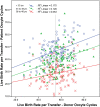Establishment of comparative performance criteria for IVF centers: correlation of live birth rates in autologous and donor oocyte IVF cycles
- PMID: 25475407
- PMCID: PMC4267438
- DOI: 10.1186/1477-7827-12-122
Establishment of comparative performance criteria for IVF centers: correlation of live birth rates in autologous and donor oocyte IVF cycles
Abstract
Background: To assess whether an objective performance criterion for in vitro fertilization (IVF) centers can be established.
Methods: A retrospective analysis of 2011 National ART Surveillance System data for 451 U.S. IVF centers, 137 of which were included in the analysis since they performed >20 fresh embryo transfers per age group and >20 fresh oocyte donor transfers. The analysis of autologous cycles was restricted to women under age 40. The main outcome measure was correlation between center-specific live birth rates (LBR) in autologous and donor oocyte cycles.
Results: 55.6% donor and 46.7%, 39.1% and 28.7% (for ages <35, 35-37 and 38-40 years) autologous cycles resulted in live births per fresh embryo transfer. Donor LBR predicted autologous LBR (< 35 years, P < 0.001; 35 - 38 years, P < 0.001; 38 - 40 years, P = 0.015). Clinics with high prevalence of patients with diminished ovarian reserve had lower autologous LBR per age group (P = 0.015). Every 10% increase in donor LBR increased odds of autologous LBR above the age-adjusted national average by 68% (OR 1.68; 95% CI 1.36 - 2.07; P < 0.001).
Conclusions: Since center-specific donor and autologous IVF cycle outcomes correlate, and as donor cycles reflect fewer patient covariates, they represent a first comparable performance measure between centers, allowing for internal as well as external quality control.
Figures
Similar articles
-
The optimum number of oocytes in IVF treatment: an analysis of 2455 cycles in China.Hum Reprod. 2013 Oct;28(10):2728-34. doi: 10.1093/humrep/det303. Epub 2013 Jul 25. Hum Reprod. 2013. PMID: 23887075
-
Oocyte or embryo number needed to optimize live birth and cumulative live birth rates in mild stimulation IVF cycles.Reprod Biomed Online. 2021 Aug;43(2):223-232. doi: 10.1016/j.rbmo.2021.02.010. Epub 2021 Feb 23. Reprod Biomed Online. 2021. PMID: 34140227
-
Pregnancy rates in donor oocyte cycles compared to similar autologous in vitro fertilization cycles: an analysis of 26,457 fresh cycles from the Society for Assisted Reproductive Technology.Fertil Steril. 2014 Aug;102(2):399-404. doi: 10.1016/j.fertnstert.2014.04.027. Epub 2014 May 17. Fertil Steril. 2014. PMID: 24842672
-
Cumulative live birth rates in in-vitro fertilization.Minerva Ginecol. 2019 Jun;71(3):207-210. doi: 10.23736/S0026-4784.18.04347-2. Epub 2018 Nov 27. Minerva Ginecol. 2019. PMID: 30486636 Review.
-
Improvements in IVF in women of advanced age.J Endocrinol. 2016 Jul;230(1):F1-6. doi: 10.1530/JOE-16-0105. Epub 2016 May 6. J Endocrinol. 2016. PMID: 27154334 Review.
Cited by
-
Pregnancy outcome and follow-up of offspring of donor oocytes recipient from PCOS patients.BMC Pregnancy Childbirth. 2022 Oct 19;22(1):779. doi: 10.1186/s12884-022-05114-y. BMC Pregnancy Childbirth. 2022. PMID: 36261799 Free PMC article.
References
-
- Centers for disease control and prevention, Assisted Reproductive Technology (ART) [http://www.cdc.gov/art/ARTReports.htm] Accessed 01/27/2014
-
- Society for Assisted Reproductive Technology (SART)[http://sart.org/find_frm.html] Accessed 1/27/2014
-
- Min JK, Breheny SA, MacLachlan V, Healy DL. What is the most relevant standard of success in assisted reproduction? The singleton, term gestation, live birth rate per cycle initiated: the BESST endpoint for assisted reproduction. Hum Reprod. 2004;19(1):3–7. doi: 10.1093/humrep/deh028. - DOI - PubMed
Publication types
MeSH terms
LinkOut - more resources
Full Text Sources
Other Literature Sources


